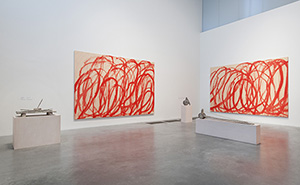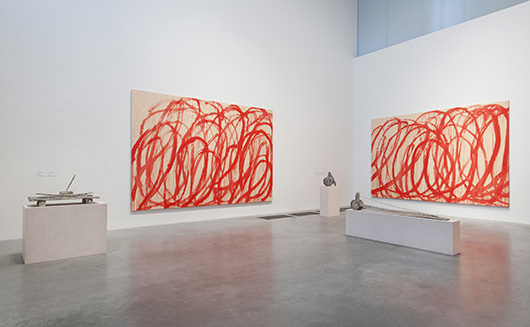
The gift comprises three large late paintings, Untitled (Bacchus) 2006-8, and five sculptures in bronze dating from the period 1979-91. These may be shown separately, or together, as in the installation of the works that is currently on view at Tate Modern. Twombly’s decision to place these works in London was made out of his admiration for Tate and his sympathy for the work of Turner, and followed his major retrospective, “Cy Twombly: Cycles and Seasons” at Tate Modern in 2008, curated by Nicholas Serota and Nicholas Cullinan.
The Roman god Bacchus is a recurring theme in Twombly’s work. In summer 2005, he returned to the Iliad for inspiration to create a cycle of eight paintings in vermilion color on the theme of the ecstasy and insanity of the Roman god. Red is the color of wine and also of blood and the three canvases encompass both the sensual pleasure and violent debauchery associated with the god. The unfurling scrolls of the paintings were made, like Matisse’s large drawings for the chapel at Vence, with a brush affixed to the end of a pole, which accounts for their vitality and scale. The three late paintings extend Twombly’s series of Bacchus paintings from 2005 and were begun on canvases dating from that first campaign of painting.
The five sculptures are all bronze casts of Twombly’s assemblages of found objects and detritus, such as the top of an olive barrel, which forms one of the works, Rotalla. Through simple elements Twombly evokes classical artifacts, such as chariots and ships, while their casting in bronze lends otherwise ephemeral objects the permanence of ancient sculpture.
“This is one of the most generous gifts ever to Tate by an artist or a foundation,” said Nicholas Serota, director, Tate. “It ranks alongside Rothko’s gift of the Seagram mural paintings in 1969 and together with Twombly’s cycle of paintings The Four Seasons 1993-5, acquired in 2002, this gives an enduring place in London to the work of one of the great painters of the second half of the 20th century.”
Cy Twombly (1928-2011) was born in Lexington, Va. He lived and worked in America and Italy. He studied in Boston, New York and at Black Mountain College in North Carolina at the height of Abstract Expressionism. He moved to Italy in 1957 where he incorporated graffiti-like pencil marks onto the surface of his early paintings, introducing elements of hesitancy and fragility into the confident physical gestures of abstract expressionist painting. Increasingly his subjects were drawn from classical antiquity, as conveyed by the poets, or through the work of poets inspired by classical example from Alexander Pope to Rilke and T.S. Eliot.
ADDITIONAL IMAGE OF NOTE


